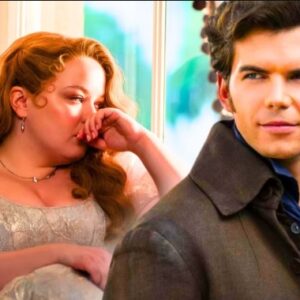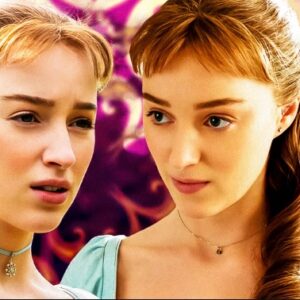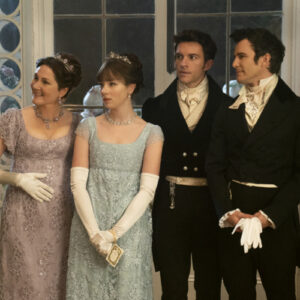Costume designer Carlos Rosario breaks down the thousands of costumes in FX’s “Shōgun.”

The Shōgun costume department spanned several countries, including the show’s main shooting location in Vancouver. There, a team of around 125 people, headed by costume designer Carlos Rosario, worked with their international collaborators — a team Rosario estimates falls between 250 and 300 people — to produce the over 2,300 costumes needed to bring Shōgun to life.
The goal? To create a range of costumes that would read as authentic to 1600 Japan, when Shōgun is set, and that would also express character in subtle, meaningful ways. In an interview with Mashable, Rosario delved into the collaborative research process behind Shōgun‘s costumes, the ways in which clothing on the show reveals status, and how costumes showcase the evolution of characters like Japanese translator and noblewoman Toda Mariko (Anna Sawai) and English pilot John Blackthorne (Cosmo Jarvis).
Shōgun‘s costumes strive for period authenticity through collaboration.

Right from pre-production, one of the most important aspects for every design element of Shōgun was ensuring authenticity. To achieve that in the series’ costuming, Rosario collaborated with historian Frederik Cryns, professor of Japanese history at the International Research Center for Japanese Studies in Kyoto. Cryns provided a historical foundation for Rosario and his team, and also directed him to paintings from the Sengoku period for inspiration directly rooted in history.
Rosario also worked with Shōgun star and producer Hiroyuki Sanada, who advocated for cultural faithfulness and specificity across the board. (At a Television Critics Association panel, Sanada declared the show a “dream East-meets-West” collaboration.) Sanada brought his longtime dresser to Vancouver to teach the costuming team how to properly dress actors in Japanese period clothing. Experts in kimono dressing also provided consultation on how to perfect the looks of Shōgun‘s women.
“By the second episode, everybody was a professional [at dressing the Shōgun actors] because they had to do that so many times every day, for so many people,” Rosario told Mashable. “It was a group effort.”
For the actual costume creation, the Shōgun team rented about 1,300 pieces and bought modern-day kimonos that they altered to give the shape of a kosode. “The kosode is the ancestor to the kimono,” Rosario explained.
By the end of filming, Shōgun‘s costume pieces filled a massive warehouse in Vancouver — something Rosario could never have dreamed of at the start of the process. “When I saw the warehouse in the beginning, I thought, ‘Oh my God, this is way too big. There’s no way we’re going to be able to fill this space,'” Rosario said. “Then, I think by the second episode, it was all filled. We had to create racks on top of each other.”
Every detail of Shōgun‘s costumes means something — especially when it comes to status.

Rosario worked to incorporate every tidbit of his research into Shōgun. For example, he learned that only lords and ladies could wear tabi — split-toe socks — indoors. As a result, you’ll notice that less influential characters are barefoot in the scenes taking place in Osaka Castle.
There’s even a hierarchy of status when it comes to the material of the tabi socks. Members of the Council of Regents wear deerskin tabi. (“Hiroyuki Sanada said he’d never seen tabi as beautiful,” Rosario said.) But the highest-ranking characters, such as Lady Ochiba (Fumi Nikaido), mother of the heir, wear tabi made of cotton. Why? “Cotton was very rare at the moment, and very expensive,” said Rosario.
Fabric as a status symbol factored into another key element of Shōgun‘s costuming: layering. “The more layers you have, obviously the more fabric you need to use, and the more expensive it gets,” Rosario said. This is why villagers in Ajiro wear one layer of clothing, while higher-ranking characters wear several.
Layering is especially important when it comes to the women of Shōgun. Rosario explained that Lady Ochiba, being the highest-ranking woman, would usually wear five or six layers, while Mariko would usually wear two or three. Even though the lowest layers of clothing weren’t always visible, Shōgun‘s costuming team worked to keep them periodically accurate. The weight of the layers proved influential to the actors’ performances, impacting their physicality and speech.
Meanwhile, Rosario relished working with so many different layers, even if some would never be seen in their entirety. “It’s how architectural it is, and how you could play with all these different tones that could work together,” he said. “It’s a beautiful moment of styling, when you have to just work with the colors.”
On the less flashy side, pay attention to the men’s hakama — wide-legged, almost skirt-like pants — for more indicators of status. More pleats means more fabric, so Ajiro’s villagers pants tend to only have one pleat, while people like Toranaga have far more.
Shōgun‘s costumes also reveal character.

In addition to emphasizing status, Shōgun‘s costumes are also hints at a character’s mental state or their place in Shōgun‘s broader narrative. In an interview with Harper’s Bazaar, Rosario spoke to how Mariko’s costumes at first depict lifeless scenes covered in snow as a reflection of her cold outlook on life. As the season continues and she embraces her role as translator for Blackthorne, her internal world comes alive. To reflect that change, Rosario incorporated flowers, brighter colors, and bolder patterns into Mariko’s looks.
Blackthorne’s costumes undergo an evolution of their own, Rosario told Mashable. We first meet him in his British clothing, including britches and a blouse. But once he’s taken in by Toranaga, he’s given a kosode. “To me, symbolically, it means he’s letting go of his identity,” said Rosario.





